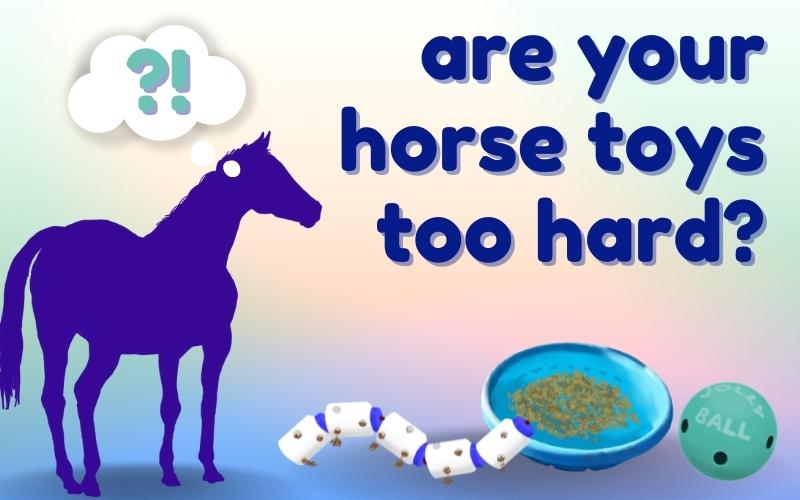
Puzzles and toys for horses have tons of benefits. And most horses have a blast playing with toys, especially food and treat puzzles. But is it possible for a food puzzle to be too hard for your horse? How do you know if a toy is too difficult? Choosing and using the right horse toys is critical – here’s how to assess puzzle difficulty and pick the best option for your horse.
Horse Toys, Horse Puzzles, and Food
Food and treat based toys and puzzles are horse enrichment items that encourage natural behaviors and problem solving, usually with a bit of challenge. That sounds complicated, but a food toy is basically any object that provides food or forage as your horse uses it.
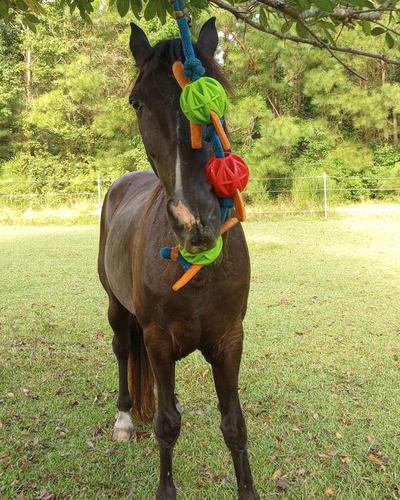
Homemade puzzles like the DIY Likit project are a good example of food toys. Commercially made puzzle feeders, like the Shires ball feeder, also count.
Not all horse enrichment involves food, but food toys are lots of fun for horses. They also offer excellent boredom relief. There’s endless variety and they are great for keeping horses occupied; food puzzles can be make-or-break for sanity during stall rest.
But because they can be challenging to solve, it’s possible for food puzzles to be too hard for your horse.
But the benefits of enrichment are huge, and it’s normal and healthy for animals to use their mind and bodies to acquire food. In fact, animals actually prefer to put in effort for a food reward compared to getting it for free, in a phenomenon called contrafreeloading.
But how can you tell if a horse toy is too difficult? What’s the line between healthy challenge and a horse puzzle that’s too hard, and what are the risks of too much difficulty?
Can food toys for horses be too hard?
Horse toys and food puzzles can be too challenging. This usually happens when the horse can’t figure out how to use the toy to get food. And since many horses are very food-motivated and horse treat toys feature really tasty rewards, it’s possible for your horse’s toys to turn from fun to frustrating.

Imagine being really hungry and holding a can of soup – with no pop tab – and not having a can opener. You know there’s food in there and you really want it, but getting it is almost impossible. That’s what a too-challenging food toy is like for your horse.
Horses are all individuals and each puzzle feeder or toy is different. No toy is too challenging for all horses, and most horses find some toys easier than others.
So what impacts a horse toy’s difficulty level? If you’re looking to buy or make food toys as a source of boredom relief, knowing where the challenge comes from can help you make the best decisions.
What Makes a Horse Toy Difficult?
Difficulty in a horse puzzle comes from a few factors.
How long to get to the reward
Toys and puzzles that provide a food reward are more challenging if it takes a lot of work before food is available. The horse has to have a lot of patience to work through the puzzle.
Ice blocks with treats frozen inside are a good example of a horse toy that takes a little effort but a lot of time depending on how big your block of ice is.
On the other side of the scale are instant-reward puzzles like the flip-up cup puzzle, which reveals food as soon as your horse nudges the cup and uncovers the treat.
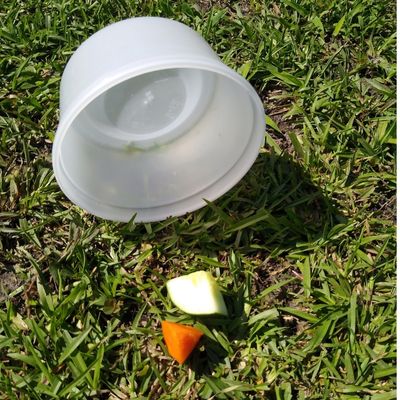
How much reward
Food items that have a low rate of reward let the horse access only a little food at a time, or create a delay in between food access. The Kong Wobbler, available on Amazon, is a good example of a toy with a low rate of reward.

How much skill to get the reward
Horse food toys don’t just require patience – the demand skill to solve as well.
Toys promote different behaviors depending on their design. This is how they provide stimulation and improve wellness. But behaviors are skills, and take time and practice to develop.
Toys that produce food with minimal skill are good for horses new to enrichment. This includes toys with big holes that easily release food, like this DIY treat roller made from a plastic canister. Lightweight items like a basic cardboard forage box usually require minimal skill to flip over and turn around.
Are Your Horse Toys Too Hard? How to Tell
Knowing the difficulty level of your horse’s puzzles and other food enrichment is important. It helps you provide a mix of items and experiences and maximum boredom relief.
The perfect food toy or horse treat puzzle offers some challenge and keeps your horse occupied for an appropriate length of time (how long depends on the design and purpose of the toy). It’s absolutely okay for your horse to spend a long time on a toy if they enjoy it. The stimulation and interest is what makes the enrichment so valuable.
Horse food toys that are too easy will empty out quickly. If your goal is to occupy your horse for a long time, like during stall rest, this can leave too much downtime.
On the other hand, too much difficulty leads to frustrated behaviors or the horse giving up. That’s not ideal either.

Plan to observe your horse while they’re using different enrichment items. Watching your horse use their toys is important to make sure they’re staying safe as well as having a good experience.
You may need to observe your horse from a distance so that they can’t tell you’re watching. Sometimes, when you’re close by, your horse may behave differently around their enrichment.
When you watch how your horse uses their toys, you can get a good idea of how challenging each one is, and make changes if needed.
Using the toy as intended
Each horse toy or food enrichment is meant to be used in a certain way. For example, a horse should use a hay net by pulling out a bite of hay with their teeth or lips. They should use a hanging Stall Snack or DIY licking toy by slurping at the insert with their tongue. And so on!
But if your horse can’t solve the puzzle or get the food reward the right way, they might turn to other methods. This is a sign that the toy might be above their current skill or knowledge level.
Using a toy the wrong way might not be safe, so this should be a red flag.
Showing calm body language
Watch your horse’s whole body while they use each toy or puzzle. Comparing how they look and act while using a food puzzle to how they look and act when simply grazing in a pasture can tell you a lot.
If their body language changes from relaxed to tight and tense when they use a toy, that’s a potential sign of frustration. Tis includes wide fixed eyes, snaking the neck low and forward in the direction of the toy, and tightly pinning back their ears.
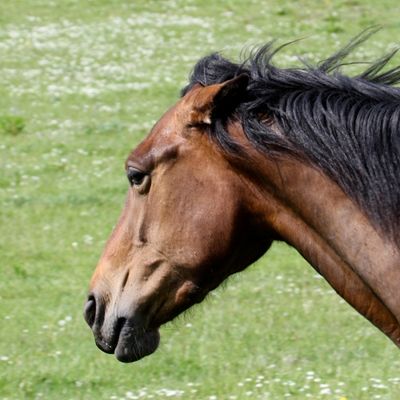
Note that it’s normal for horses to pull their ears back while working on toys, just to keep them out of the way. This isn’t the same as tightly pinning down the ears to signal anger. Knowing the difference is important! The picture below shows a horse who is busy and engaged, with ears swiveled away from the tree branches:
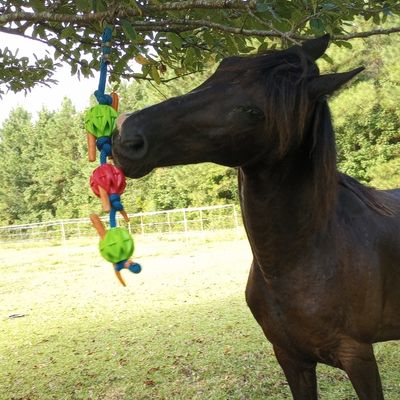
Other signs of frustration
Other signs that your horse’s toys are too difficult include intense or escalating behaviors. This means that the horse might act with more energy, or start abusing a toy by slamming it around or trying to break it.
Damage and excessive wear
Damage or excessive wear can indicate that toys are too hard for your horse. Some wear and tear is normal because horses are big and powerful animals. But if you find that your horse’s toys consistently get broken, or you see excessive wear and tear on certain parts of toys, that’s a sign to pay closer attention.
Chewing near holes where treats come out of toys, warped or torn hay nets, or items simply busted apart all indicate that your horse’s toys or enrichment are above their skill level.
What to do if toys are too hard for your horse
What can you do if a toy is too difficult for your horse?
First, make sure that difficulty is a problem at all! Just like some humans enjoy time consuming hobbies, some horses are completely happy taking a long time to use a puzzle or getting only a small amount of reward at a time from a toy.
Horses with more experience with enrichment and without a history of food anxiety are more likely to appreciate challenging toys. Let your horse’s behavior and body language determine whether the toy is really too difficult. And remember, enrichment is one of the main ways to reduce boredom. This means that more interaction and time should eventually be your goal!
If you do determine that your horse is uncomfortable and frustrated, don’t take the item off the table completely. Often, small changes can make the toy easy enough to use that your horse has a much better experience.
Making Food Puzzles Easier
Try these steps, depending on the enrichment toy or puzzle, to make them work better for your horse:
- Widen holes by cutting them a bit larger or filing their openings
- Add more holes to treat dispensing containers
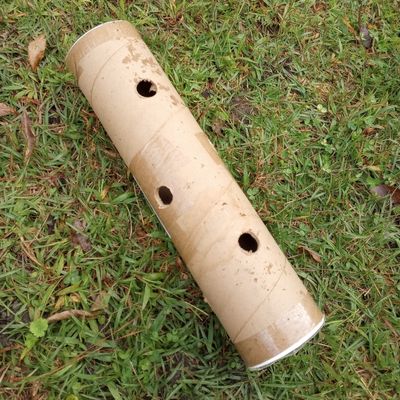
- Add more treats, feed, or forage to the toy
- Cut treats for rolling or moving puzzles into smaller pieces so that they easily drop out of holes
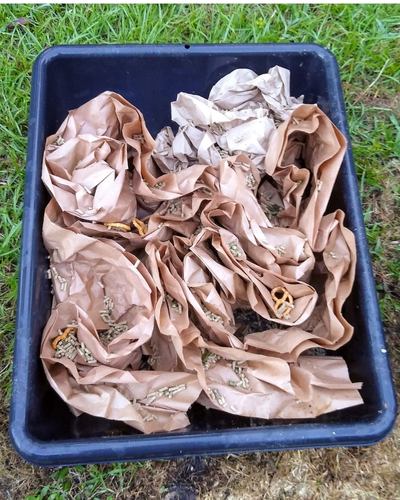
- Tie or anchor down rolling or swinging items so they cannot move as much
- Use shorter cords for hanging horse toys so that they have less motion
These strategies can often allow you to continue using the toy or puzzle for your horse, with a slightly lower difficulty level. When your horse is comfortable and skilled at their simplified toy, you can gradually introduce them to more challenging versions.
And if your modified toy still doesn’t meet your horse’s needs, try a different style of enrichment item. Puzzles and toys for horses come in a huge variety, and horses do have preferences! With a little experimenting, you can find an array of toys that aren’t too hard for your horse to solve.
Related Topics
This article is all about how your horse thinks and acts around their enrichment! For more deep-dive topics, try these articles:
Is My Horse Bored? Signs of Equine Boredom